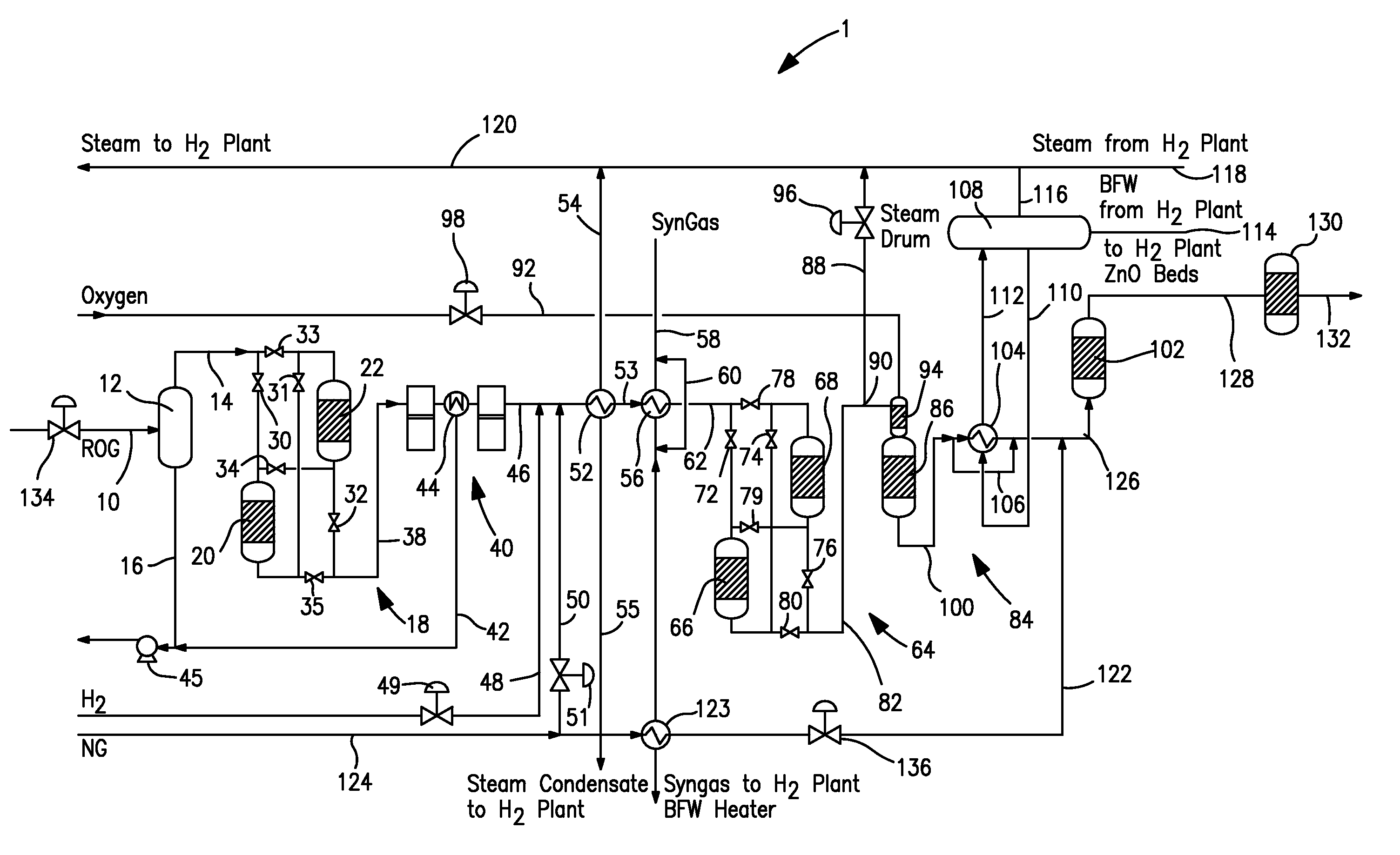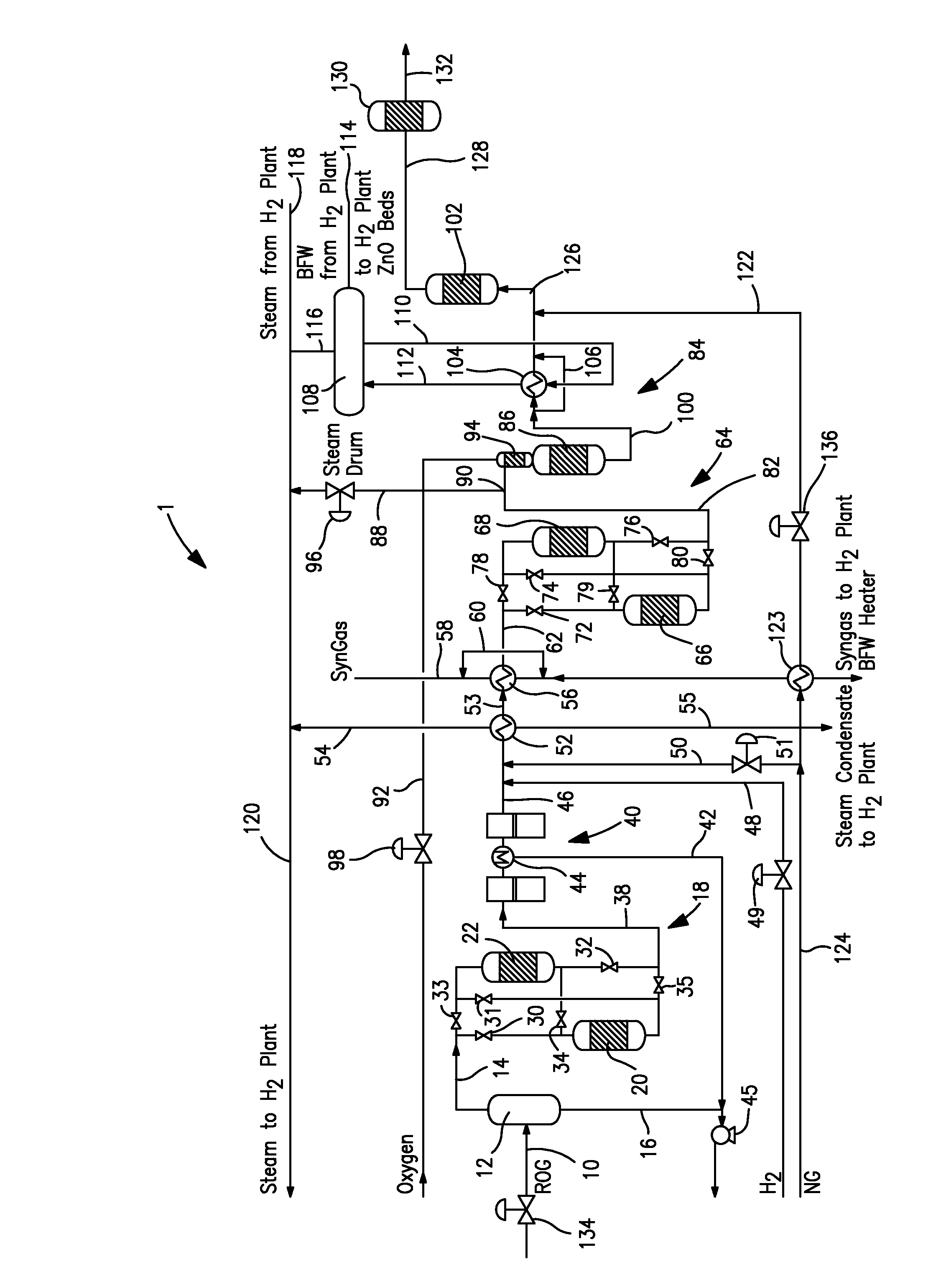[0007]As will be discussed, the present invention provides a method and apparatus that utilizes a sulfur tolerant catalyst, such as described above, that among other advantages, allows operations to be conducted at higher space velocities and therefore, permits the reactor to be more compact and less expensive and / or able to accommodate higher flow rates of hydrocarbon containing streams to be treated.
[0008]The present invention, in one aspect, provides a method of producing a treated hydrocarbon containing stream for use as a feed to a steam
methane reformer of a hydrogen plant. In accordance with such method, an untreated hydrocarbon containing feed stream of variable composition comprising hydrocarbons that contain two or more carbon atoms including olefins, organic sulfur species and hydrogen is contacted with a sulfur tolerant catalyst contained within a reaction stage and capable of promoting both hydrogenation and oxidation reactions. Part of the olefins is converted into saturated hydrocarbons and part of the sulfur species is converted to
hydrogen sulfide within the reaction stage, thereby to produce a first intermediate stream. The first intermediate stream is produced through hydrogenation reactions promoted by the catalyst or by introducing sufficient
oxygen and steam into the reaction stage such that oxidation reactions are promoted by the catalyst resulting in saturated hydrocarbons, methane, additional hydrogen and
carbon monoxide being produced from the hydrocarbons contained in the untreated hydrocarbon containing feed stream.
[0014]A hydrotreater is provided in flow communication with the reactor so as to receive at least the first intermediate stream and to produce a second intermediate stream having a greater amount of the
hydrogen sulfide than that of the first intermediate stream and lower amounts of the olefins and the organic sulfur species than that of the first intermediate stream through hydrogenation of olefin slip and conversion of organic sulfur species slip in the first intermediate stream with the use of another catalyst capable of solely promoting hydrogenation reactions. A
zinc oxide bed associated with the hydrogen plant and connected to the hydrotreater is provided to adsorb the increased hydrogen
sulfide content in the second intermediate stream, thereby to produce the treated hydrocarbon containing stream.
[0010]The untreated hydrocarbon containing feed stream can be a
refinery off-gas and can be compressed to a pressure greater than a preheated
natural gas stream produced in the hydrogen plant. The first intermediate stream is combined with the preheated
natural gas stream to produce a combined stream containing between about 0.5 mol percent and 6 mol percent by volume olefins on a
dry basis and less than about 25 ppm by volume of total sulfur on a
dry basis. In this regard, the term “total sulfur” as used herein and in the claims means both organic sulfur species and hydrogen
sulfide. The combined stream is introduced into the hydrotreater, thereby to produce the second intermediate stream having no greater than about 0.5 mol percent of the olefins on a dry basis and of no greater than about 0.1 ppm by volume of the total sulfur on a dry basis.
[0011]The first intermediate stream can be passed through a boiler to generate saturated steam for the hydrogen plant and is thereby cooled to a temperature of between about 260° C. and about 480° C. prior to being combined with the preheated natural gas stream. Prior to the untreated hydrocarbon containing feed stream being introduced into the reaction stage, the untreated hydrocarbon containing feed stream, after compression, is: preheated to a temperature of about 230° C. through indirect heat exchange with steam generated in the hydrogen plant; preheated in a feed preheater through indirect heat exchange with a synthesis gas stream produced in the hydrogen plant to a temperature of between about 260° C. and about 400° C.; and thereafter, subjected to a pretreatment stage configured to remove incoming hydrogen
sulfide from the untreated hydrocarbon containing feed stream.
[0012]Prior to and / or after the untreated hydrocarbon containing feed stream being compressed, the stream can be passed into a knockout drum to separate free liquids contained in the hydrocarbon containing stream and thereby to produce a condensate stream. Prior to or after the untreated hydrocarbon containing feed stream being compressed,
sulfur containing compounds can be removed therefrom in a bulk sulfur removal stage.
[0013]In another aspect, the present invention provides an apparatus for producing a treated hydrocarbon containing stream for use as a feed to a steam
methane reformer of a hydrogen plant. In accordance with this aspect of the present invention, the apparatus comprises a reactor configured to receive an untreated hydrocarbon containing feed stream of variable composition comprising hydrocarbons that contain two or more carbon atoms including olefins, organic sulfur species and hydrogen. The reactor contains a sulfur tolerant catalyst capable of promoting both hydrogenation and oxidation reactions contained within the reactor. The reactor is configured to convert part of the olefins into saturated hydrocarbons and at least part of the sulfur species to hydrogen sulfide, thereby to produce a first intermediate stream, through selective
modes of operation. In a hydrogenation mode, hydrogenation reactions are promoted by the catalyst or in a pre-reforming mode, steam and
oxygen are received within the reactor, oxidation reactions are promoted by the catalyst resulting in the saturated hydrocarbons, methane, additional hydrogen and
carbon monoxide being produced from hydrocarbons contained in the untreated hydrocarbon containing feed stream.
[0014]A hydrotreater is provided in flow communication with the reactor so as to receive at least the first intermediate stream and to produce a second intermediate stream having a greater amount of the hydrogen sulfide than that of the first intermediate stream and lower amounts of the olefins and the organic sulfur species than that of the first intermediate stream through hydrogenation of olefin slip and conversion of organic sulfur species slip in the first intermediate stream with the use of another catalyst capable of solely promoting hydrogenation reactions. A
zinc oxide bed associated with the hydrogen plant and connected to the hydrotreater is provided to adsorb the increased hydrogen sulfide content in the second intermediate stream, thereby to produce the treated hydrocarbon containing stream.
[0015]A mixer
assembly can be provided in flow communication to the reactor and to conduits supplying the steam, the oxygen and the hydrocarbon containing feed stream such that a mixture containing the hydrocarbon containing feed stream, the steam and oxygen is received in the reactor and contacts the catalyst.
Control valves are in flow communication with the conduits supplying the steam and oxygen to the mixer. The
control valves are configured to be set in open positions to allow the oxygen and steam to be received within the reactor during the pre-reforming mode of operation.
[0016]A compressor can be provided to compress the untreated hydrocarbon containing feed stream to a pressure greater than a preheated natural gas stream produced in the hydrogen plant. A natural gas line is in flow communication with the hydrotreater so that the first intermediate stream is combined with the preheated natural gas stream to form a combined stream and the combined stream is introduced into the hydrotreater, thereby to produce the second intermediate stream. Further, a boiler can be positioned between the reactor and the hydrotreater such that the first intermediate stream is passed through the boiler to generate saturated steam for the hydrogen plant and is thereby cooled prior to being combined with the preheated natural gas stream. A preheater is connected to the compressor to preheat the untreated hydrocarbon containing feed stream through indirect heat exchange with steam generated in the hydrogen plant and a feed preheater is connected to the preheater to further preheat the untreated hydrocarbon containing feed stream through indirect heat exchange with a synthesis gas stream produced in the hydrogen plant. A pretreatment stage is positioned between the feed preheater and the reactor and is configured to remove incoming hydrogen sulfide from the untreated hydrocarbon containing feed stream. In addition, a knockout drum can be positioned upstream of each compressor stage and receives the untreated hydrocarbon containing feed stream, thereby to separate free liquids contained in the untreated hydrocarbon containing feed stream and to produce a condensate stream. A bulk sulfur removal stage is positioned between the knockout drum and the compressor or downstream of the compressor and is configured to remove
sulfur containing compounds from the untreated hydrocarbon containing feed stream.
[0017]While the specification concludes with claims distinctly pointing out the
subject matter that Applicants regard as their invention, it is believed that the invention will be better understood when taken in connection with the accompanying sole FIGURE that illustrates a
process flow diagram of an apparatus for carrying out a method in accordance with the present invention.
 Login to View More
Login to View More  Login to View More
Login to View More 

